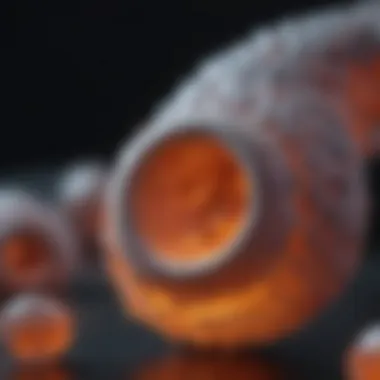Advancements in Bladder Cancer Research and Treatment


Intro
Bladder cancer remains a pressing public health issue globally. Recent advances in research have shed light on its underlying mechanisms, promising new insights into prevention, diagnosis, and treatment. Understanding these developments is essential for students, researchers, educators, and professionals involved in oncology. This article delves into current research focusing on various aspects of bladder cancer, integrating new findings and perspectives that may change the landscape of management for this malignancy.
Research Overview
Recent studies on bladder cancer have unveiled key findings that inform our understanding of the disease. Researchers have identified several critical factors influencing bladder cancer pathology, including environmental exposures, genetic predispositions, and lifestyle choices. The increasing role of biomarkers for early detection and personalized treatment is also noteworthy. Emerging data suggest that integrating precision medicine can lead to tailored therapies.
Summary of Key Findings
- Investigations into the molecular genetics of bladder cancer have revealed specific gene mutations correlated with tumor aggressiveness.
- The use of advanced imaging technologies enhances early diagnosis, improving treatment outcomes significantly.
- Immunotherapy, specifically checkpoint inhibitors, shows promise in treating patients with advanced stages of the disease.
Methodologies Employed
Research on bladder cancer employs various methodologies:
- Epidemiological Studies: These studies help identify risk factors and patterns in patient populations.
- Genomic Analysis: Next-generation sequencing provides insights into genetic variations linked to bladder cancer.
- Clinical Trials: These trials evaluate the effectiveness of new therapeutic approaches, including drugs and interventions.
In-Depth Analysis
The depth of recent findings offers a granular view of bladder cancer's complexities. This section examines the latest research results, their significance, and how they align with historical data.
Detailed Examination of Results
Recent advancements highlight the critical role of immune responses in bladder cancer pathology. For instance, studies suggest that tumor-infiltrating lymphocytes can predict therapeutic responses to immunotherapy. Other studies indicate that specific biomarkers can guide treatment decisions effectively. Research continues to explore how genetic profiles can predict patient outcomes and therapy responses.
Comparison with Previous Studies
Comparing current research with earlier studies reveals significant strides in our understanding of bladder cancer. Earlier models focused primarily on chemotherapy; however, contemporary research emphasizes the integration of immunotherapy and precision medicine. The comparison underscores how the evolving landscape can lead to improved patient management strategies and tailored treatment regimens.
"Advancements in understanding bladder cancer at a molecular level are essential for developing targeted therapies that not only treat the disease but also enhance patients’ quality of life."
Understanding Bladder Cancer
Understanding bladder cancer is crucial in discussing the advancements and research surrounding this disease. This section lays the foundation for comprehending not just the disease itself, but also its prevalence, forms, and associated risks. Bladder cancer is not only a medical issue but a public health concern affecting thousands globally each year. By diving into its definition, epidemiology, subtypes, and risk factors, we can better appreciate the complexities involved in diagnosis and treatment, thus aiding researchers and healthcare providers in their quest for more effective strategies.
Definition and Epidemiology
Bladder cancer arises from the tissues of the bladder, the organ responsible for storing urine. It is characterized by the uncontrolled growth of cells lining the bladder. It is essential to note that bladder cancer ranks as the fourth most common cancer among men and the ninth among women in many countries.
Epidemiological studies indicate a significant incidence rate among older adults, primarily affecting individuals over the age of 55. In particular, there is a higher prevalence in Caucasian men compared to other ethnic groups. Common symptoms include hematuria, frequent urination, and pain during urination, which often lead individuals to seek medical evaluation. The global burden highlights the need to understand demographic trends and geographical variations in bladder cancer occurrence.
Subtypes of Bladder Cancer
Bladder cancer is not a single entity but comprises several subtypes, each with distinct characteristics. The primary subtypes are:
Transitional Cell Carcinoma
Transitional cell carcinoma, also known as urothelial carcinoma, is the most common type, accounting for approximately 90% of bladder cancer cases. This subtype develops from the transitional cells that line the bladder. Its primary attribute is the capacity to stretch and change shape, allowing it to accommodate varying volumes of urine.
Transitional cell carcinoma often presents itself in multifocal lesions, meaning it can develop in multiple areas of the bladder simultaneously.
This unique feature makes early detection and treatment challenging but provides a window for opportunities to employ advanced diagnostic techniques discussed later in this article.
Squamous Cell Carcinoma
Squamous cell carcinoma is less common, representing about 4% of bladder cancer cases. This subtype results from prolonged irritation to the bladder lining, often linked to chronic inflammation or infection, such as schistosomiasis. The key characteristic of squamous cell carcinoma is that it originates from squamous cells, which are flat cells that can develop under mucosal irritation.
Although less frequent, its emergence in certain populations emphasizes the need to consider risk factors related to infectious diseases.
Adenocarcinoma


Adenocarcinoma is another rare subtype, constituting less than 2% of bladder cancer cases. This type emerges from glandular cells in the bladder lining. The unique feature of adenocarcinoma lies in its association with chronic irritation or inflammation and the potential connection to other diseases like bladder exstrophy.
Despite its rarity, understanding adenocarcinoma is crucial as it may exhibit different biological behaviors compared to the more prevalent transitional cell carcinoma. Notably, it tends to be more aggressive and often diagnosed at a later stage, increasing the complexity of treatment options.
Risk Factors and Causes
A comprehensive understanding of bladder cancer also involves identifying significant risk factors and causes.
Tobacco Use
One of the most prominent risk factors for bladder cancer is tobacco use. Smoking increases the risk significantly, with smokers being three times more likely to develop the disease than non-smokers. The harmful substances present in tobacco smoke are believed to cause direct damage to the bladder's lining. As a prevalent habit, tobacco use presents a critical area for preventive interventions.
Chemical Exposure
Chemical exposure encompasses a range of industrial chemicals, including aniline dyes, benzidine, and certain solvents. Workers in industries such as dye manufacturing and rubber production may face heightened risk levels. Due to the potential links between these substances and bladder cancer, it is vital to prioritize adequate occupational safety measures to mitigate exposure risks.
Chronic Inflammation
Chronic inflammation can be a significant contributor to bladder cancer. Conditions like chronic cystitis or urinary tract infections can cause repeated irritation of the bladder lining. The prolonged presence of inflammation can potentially lead to genetic mutations, ultimately increasing cancer risk. Recognizing the importance of managing chronic conditions is essential in reducing bladder cancer incidence.
Understanding these factors enables more targeted prevention and early detection strategies, leading to better outcomes and a clearer approach to treatment.
Recent Advances in Diagnostic Techniques
The evolution of diagnostic techniques for bladder cancer has been significant and crucial for enhancing patient outcomes. Accurate diagnosis is the cornerstone of effective treatment. Therefore, recent advances in this area are not just technical improvements but pivotal elements in the management of bladder cancer. This includes the discovery and implementation of various biomarkers, imaging techniques, and cystoscopic developments, all aimed at increasing precision in diagnosis and subsequently in treatment.
Urinary Biomarkers
Urinary biomarkers have emerged as non-invasive tools in the detection and monitoring of bladder cancer. These markers allow for the analysis of urine samples, which can reveal the presence of cancerous cells or other indicators of disease. One common application is the NMP22 test, which measures nuclear matrix protein levels that are often elevated in bladder cancer patients. Another example is UroVysion, a test that assesses chromosomal abnormalities in urine specimens. The primary benefit of using urinary biomarkers is their ability to reduce the need for invasive procedures. However, while promising, these tests also require further validation to ensure reliability and specificity.
Imaging Advances
Advancements in imaging have transformed how bladder cancer is diagnosed and assessed. Newer imaging methodologies contribute to more accurate staging and detecting recurrences. A couple of notable innovations include:
CT and MRI Innovations
CT and MRI innovations have enhanced the visual representation of bladder structures and surrounding tissues. A key characteristic of these imaging modalities is their ability to provide high-resolution images. This helps in identifying tumors that may not be visible through traditional methods. One of the unique features of CT scans is their speed; they can produce detailed images in a short time, which is vital for emergency cases. On the other hand, MRI is advantageous for soft-tissue identification and characterizing tumors without relying on ionizing radiation. The primary disadvantage lies in accessibility; MRI machines are not available in all facilities, leading to potential delays in diagnoses for some patients.
PET Imaging
PET imaging stands out for its functional imaging capabilities, which track metabolic activity. This is especially useful in cases where traditional imaging might not indicate the presence of cancer clearly. The key characteristic of PET is its ability to provide insight into how tumors respond to therapies. It can differentiate between benign and malignant tissues based on metabolic differences, making it a potent tool in bladder cancer assessment. While PET imaging has many benefits, it is also expensive and requires specialized equipment, which could limit its wider application in routine diagnostics.
Cystoscopy Developments
Cystoscopy remains essential in the diagnosis and monitoring of bladder cancer. Recent innovations have greatly improved this technique, making it more effective and less uncomfortable for patients.
Fluorescence Cystoscopy
Fluorescence cystoscopy involves the use of special dyes that fluoresce under specific lighting conditions, allowing for better visualization of tumors. The main characteristic of this technique is its ability to highlight cancerous areas that may not be detected through routine cystoscopy. This makes it a beneficial addition to standard practices. The unique feature of fluorescence cystoscopy is its enhanced sensitivity compared to traditional methods, significantly leading to increased detection rates of superficial tumors. However, it requires specialized equipment and training, which might not be available in all medical settings.
Enhanced Imaging Techniques
Enhanced imaging techniques during cystoscopy, such as narrow band imaging, provide improved visualization of the bladder lining. These methods use special filters to enhance the contrast of the blood vessels and mucosal surfaces. The key characteristic is its non-invasive nature combined with the ability to provide real-time feedback during procedures. This allows for better decision-making by the medical team. An advantage is that it can help detect various abnormalities, not just tumors. However, users must be adept at interpreting the enhanced images since misinterpretation can lead to false conclusions.
In summary, recent advances in diagnostic techniques emphasize the continuing evolution in handling bladder cancer. From urinary biomarkers to advanced imaging technologies, these tools are reshaping how healthcare providers approach diagnosis and treatment planning.
Novel Treatment Modalities
Novel treatment modalities in bladder cancer exemplify the constant evolution in the field of oncology. These treatments reflect a shift from traditional methods, offering targeted approaches that enhance efficacy and reduce side effects. With the rise of personalized medicine, innovative treatments provide hope for better outcomes and improved quality of life for patients.
Chemotherapy Advances
Intravesical Chemotherapy


Intravesical chemotherapy involves delivering chemotherapy drugs directly into the bladder through a catheter. This method concentrates the drug on the tumor site while limiting systemic exposure, reducing adverse effects commonly found in systemic therapy. One significant aspect of this approach is its ability to effectively manage superficial bladder cancer, often resulting in lower recurrence rates.
Though widely recognized for its advantages, intravesical chemotherapy's unique feature lies in its accessibility and relative ease of administration. Patients often undergo treatment in an outpatient setting and experience fewer debilitating effects compared to traditional intravenous chemotherapy. However, challenges remain, including the need for repeated treatments and potential discomfort during administration.
Systemic Chemotherapy
Systemic chemotherapy refers to the administration of drugs that circulate throughout the body, targeting cancer cells wherever they may exist. This broad approach is particularly useful for muscle-invasive bladder cancer, as it aims to eradicate micrometastatic disease. Its key characteristic is the use of cytotoxic agents that can dramatically shrink tumors, leading to improved surgical outcomes.
Despite its effectiveness, systemic chemotherapy presents its unique challenges. Patients often endure significant side effects such as nausea, fatigue, and immunosuppression. Additionally, dose adjustments may be necessary based on individual tolerance. Nevertheless, systematic chemotherapy plays a crucial role in the management of advanced bladder cancers, facilitating potential patient survival and quality of life improvement.
Immunotherapy in Bladder Cancer
Checkpoint Inhibitors
Checkpoint inhibitors have garnered attention within bladder cancer treatment due to their ability to unleash the immune system against malignant cells. This therapy targets specific proteins, such as PD-1 and CTLA-4, that inhibit immune responses, effectively providing a pathway for T-cells to attack tumors. This method has been notable for treating advanced bladder cancer, demonstrating significant response rates and durability in some patients.
The key feature of checkpoint inhibitors is their potential for long-lasting effects, even after treatment cessation. Unlike traditional therapies, responses may continue for months, providing a compelling alternative for those who have exhausted other options. However, immune-related adverse events can present challenges, demanding continuous management and adjustment of treatment approaches.
Cancer Vaccines
Cancer vaccines represent an innovative approach in bladder cancer therapy. These treatments aim to stimulate the immune system to recognize and attack bladder cancer cells specifically. The unique aspect of cancer vaccines lies in their potential for personalized treatment, as they can be developed based on specific tumor markers unique to each patient, offering targeted therapy tailored to individual genetic profiles.
While still in the experimental stages, cancer vaccines show promise in combination with other treatments. They are particularly beneficial as adjunctive therapy, enhancing the overall response to treatment. However, challenges remain regarding efficacy and the need for further research to determine the best deployment strategies.
Targeted Therapies
Targeted therapies focus on specific molecular characteristics of bladder cancer, aiming to inhibit cancer growth more precisely than traditional methods. These therapies offer a promising approach to personalization in treatment, allowing clinicians to select treatments based on the individual tumor’s genetic makeup. This strategy can enhance efficacy and reduce unnecessary side effects, marking a significant shift in cancer care.
Genetic Insights into Bladder Cancer
Understanding the genetic landscape of bladder cancer is critical for both diagnosis and treatment. Genetic insights reveal the biological mechanisms that underlie this disease, guiding personalized therapy approaches and fostering better patient management. These insights may contribute to more effective prevention strategies and ultimately improve patient outcomes. As research progresses, it is becoming evident that genetics play a pivotal role in understanding tumor behavior, prognosis, and response to treatment.
Genomic Profiling
Genomic profiling involves analyzing the complete set of genes in bladder cancer cells. This process allows researchers to identify mutations and alterations that drive cancer progression. Through next-generation sequencing and other advanced techniques, scientists can uncover specific gene changes associated with various bladder cancer subtypes. This information can help in selecting targeted therapies that align with the genetic profile of the tumor.
Genomic profiling provides several benefits:
- Identifying actionable mutations: Understanding mutations in genes such as FGFR3 or TP53 can guide targeted treatment, significantly impacting patient outcomes.
- Tailoring treatment plans: Therapies can be tailored based on the unique genetic makeup of the tumor, providing a more personalized approach to treatment.
- Informing prognosis: Genetic alterations can serve as prognostic biomarkers, helping clinicians predict disease outcomes and recurrence risk.
Mutation Spectrum
The mutation spectrum reflects the variety of genetic changes found in bladder cancer. Research has determined that bladder cancer exhibits a complex mutation profile, with common mutations in genes like TP53, RTK, and MMR genes. This complexity complicates treatment and may lead to therapy resistance.
Characterizing the mutation spectrum has implications for:
- Understanding Clinical Variability: Variability in mutation profiles can explain differences in treatment responses among patients, highlighting the need for individualized care strategies.
- Discovery of new therapeutic targets: By identifying novel mutations, researchers can explore new potential targets for drug development, opening doors for innovative treatments.
- Predicting treatment resistance: Certain mutation patterns may indicate a higher likelihood of resistance to specific therapies, guiding clinicians in selecting alternative treatment options.
The Role of Epigenetics
Epigenetics refers to heritable changes in gene expression that do not involve changes to the underlying DNA sequence. In bladder cancer, epigenetic modifications can significantly affect tumor behavior. These modifications can influence gene activity and contribute to processes such as tumor cell proliferation and invasion.
Key aspects of epigenetics in bladder cancer include:
- DNA Methylation: Abnormal methylation patterns can silence tumor-suppressor genes, driving cancer progression.
- Histone Modifications: Changes in histone proteins can alter chromatin structure, impacting gene accessibility and expression.
- Therapeutic Implications: Understanding epigenetic changes opens avenues for new treatment strategies. Drugs targeting epigenetic modifications are being explored in clinical trials, presenting potential opportunities for bladder cancer patients.
"Epigenetic reprogramming represents a promising frontier in the quest for novel therapeutic strategies in bladder cancer."
Loopholes in Current Treatment Protocols
Understanding the deficiencies in existing protocols for bladder cancer treatment is essential. These loopholes can compromise the effectiveness of care, impede patient outcomes, and highlight the necessity for ongoing research and refinement in treatment strategies. Addressing treatment resistance and disparities in care is crucial for improving patient experiences and survival rates.
Treatment Resistance


Treatment resistance remains a significant challenge in managing bladder cancer. Many patients exhibit an initial response to therapies, but later may develop resistance. This phenomenon can be attributed to several factors, including genetic mutations and tumor microenvironment changes. Awareness of resistance patterns can guide physicians in personalizing treatment approaches.
- Genetic Factors: Mutations can alter tumor characteristics, making them less susceptible to established therapies.
- Drug Mechanisms: Some cancer cells adapt by activating alternative pathways that circumvent the effects of treatment.
Recognizing and overcoming treatment resistance can lead to improved therapeutic strategies and better outcomes.
Disparities in Care
Disparities in care refer to the uneven access to treatments across different populations. This issue underscores the inequality that exists within healthcare systems, often resulting in poorer outcomes for some groups. Understanding these disparities is vital for fostering equitable treatment practices.
Access to Treatment
Access to treatment plays a critical role in bladder cancer management. It encompasses the availability of medical resources, financial capacity, and logistical considerations. Identifying barriers to access can shed light on issues within healthcare systems.
- Key Characteristics: Insurance coverage, proximity to specialized care, and availability of newly developed therapies can significantly influence patient choices.
- Advantages/Disadvantages: When patients lack access to prompt and effective treatments, it can lead to late-stage diagnosis and poorer prognoses.
Ensuring equitable access to bladder cancer treatments remains an important aspect of improving overall patient care.
Socioeconomic Factors
Socioeconomic factors significantly impact treatment outcomes. These include income levels, education, and overall health insurance coverage. Patients from lower socioeconomic backgrounds may experience barriers that limit their treatment options.
- Key Characteristics: A lack of financial resources can prevent patients from seeking timely care or adhering to treatment regimens.
- Advantages/Disadvantages: Addressing socioeconomic barriers can enhance patient outreach and facilitate better healthcare delivery.
Improving awareness of how socioeconomic factors influence bladder cancer care may foster initiatives to bridge these gaps, leading to better patient care.
Future Directions in Bladder Cancer Research
The landscape of bladder cancer research is constantly evolving. As science advances, identifying future directions is crucial for improving diagnosis, treatment, and patient outcomes. Researchers are focused on uncovering new therapeutic targets, utilizing big data for insights, and adopting multidisciplinary approaches. These directions promise to enhance our understanding of bladder cancer and lead to more effective management strategies.
Emerging Therapeutic Targets
Recent studies have highlighted several emerging therapeutic targets in bladder cancer. Researchers are investigating pathways that drive tumor growth and survival. For example, the fibroblast growth factor receptor (FGFR) has gained attention due to its frequent mutations in bladder tumors. Targeting FGFR with inhibitors like erdafitinib shows promise in clinical trials.
Additionally, B-cell lymphoma 2 (BCL-2) inhibitors are being tested, focusing on their ability to induce apoptosis in cancer cells. Modulating the immune system also opens avenues for novel therapies, such as targeting the programmed cell death protein 1 (PD-1) pathway. Tailoring treatment based on the tumor's genetic profile can lead to more personalized and effective strategies.
Role of Big Data in Research
Big data plays an expanding role in bladder cancer research. By aggregating vast amounts of genetic, clinical, and lifestyle data, researchers can uncover patterns that were previously invisible. Such analyses can lead to identifying patients at risk and tailoring surveillance strategies based on individual risk factors.
Moreover, machine learning algorithms can assist in predicting responses to different therapies. For instance, integrating genomic data with clinical outcomes helps identify biomarkers for treatment response. This approach not only enhances patient care but also optimizes clinical trial designs, ensuring that the right patients receive the most suitable therapies.
Multidisciplinary Approaches
Adopting multidisciplinary approaches is vital for progressing bladder cancer research. Collaboration between urologists, oncologists, pathologists, and geneticists enables a more comprehensive understanding of the disease. Each expert contributes unique insights, fostering a holistic view of patient care.
Furthermore, incorporating patient perspectives into research can guide the development of new therapies. Engaging patients in clinical trials and decision-making ensures that research is aligned with their needs and preferences. Multidisciplinary teams are better positioned to tackle the complexities of bladder cancer, producing innovative solutions that single disciplines may overlook.
"The future of bladder cancer research is not just a singular path but a tapestry woven from multiple disciplines and vast datasets. Such a comprehensive approach will potentially define new standards for treatment and patient care."
Epilogue
The conclusion of this article serves as a critical synthesis of the vast developments in bladder cancer research. In this realm, the significance cannot be understated. As researchers dig deeper into the biology of bladder cancer, what emerges is a clearer picture of prevention, diagnosis, and treatment. Fundamental discoveries highlight the nuances of the disease, from its genetic underpinnings to the disparity in treatment access faced by many patients.
Summarizing Key Insights
Recent findings emphasize the strides made in several areas:
- Advances in Diagnostic Methods: Innovations such as urinary biomarkers and advanced imaging have redefined how bladder cancer is detected and monitored. These methods help in early detection, increasing the chances of successful outcomes.
- Novel Treatment Strategies: The integration of immunotherapy and targeted therapies presents new hope for patients. Checkpoint inhibitors, specifically, have changed the therapeutic landscape, providing options where traditional chemotherapy may fail.
- Genetic Research Insights: Understanding mutations and epigenetic changes assists in tailoring personalized treatment plans. This underscores the importance of precision medicine in managing bladder cancer.
These insights underline the ongoing evolution in our understanding and tackling of the disease. Collaboration among researchers, clinicians, and patients plays a crucial role in pushing these advancements forward.
The Path Forward for Research and Treatment
The future of bladder cancer research hinges on several pivotal factors:
- Continued Research Funding: Sustained investment in bladder cancer research is necessary. Increased funding can support clinical trials and the development of innovative therapies.
- Improving Health Disparities: Efforts are essential to ensure equitable access to treatments. Addressing socioeconomic factors that affect care is a priority that needs immediate attention.
- Multidisciplinary Approaches: Collaboration across various fields, including genetics, pharmacology, and public health, will enhance the understanding of bladder cancer and inform better patient management strategies.
- Integration of Big Data: Leveraging big data analytics in research can lead to breakthroughs in identifying patterns and predicting patient outcomes, offering insights that may have previously gone unnoticed.
As each of these elements comes together, it holds the potential to not only advance research but ultimately improve treatment outcomes for patients. The landscape of bladder cancer is changing, and by adhering to these principles, further progress is within reach.















